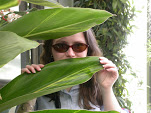Plant Sales Live on JuliaRedman.com
 As a plant geek I often field questions about orchids and plants in general. I actually enjoy this, since like most people I like to talk about the things I'm most passionate about. But it has occurred to me that people might appreciate and benefit from a series of plant care and techniques posts. This is the first of several I have planned. If you have requests, please let me know.
As a plant geek I often field questions about orchids and plants in general. I actually enjoy this, since like most people I like to talk about the things I'm most passionate about. But it has occurred to me that people might appreciate and benefit from a series of plant care and techniques posts. This is the first of several I have planned. If you have requests, please let me know.
Basic Phalaenopsis care seemed like a great place to start since many people get a Phal as a first orchid. Most of the species and hybrids are adaptable and easy to grow in typical home conditions (although there are some species and some rare hybrids that have special needs, but these are also less commonly available).
• Light: An unobstructed East or West facing window is best. South facing with some midday shade or a sheer curtain is ok. Fluorescent lights (2-4 tubes, 8-12 inches from plant) may also be used.
• Water: More orchids are killed by too frequent watering than anything else; but don’t be afraid to water your plants. For Phalaenopsis hybrids, water when media is dry about 2 inches down—test with your finger. Water freely from the top of the media, letting pot drain. Do not leave sitting in water. They will need water once per week on average, adjusting up or down with seasonal changes in temperature and humidity.
• Feeding: Use a ½ to ¼ strength solution of balanced fertilizer about once per month.
• Temperature: Average house temperature is fine (65-85F).
• Other: Repotting is recommended every two years. Misting leaves is not recommended. I do not recommend pebble trays either. The plant will adjust to the humidity levels in your house.
Soon to follow: posts on repotting and mounting plants. Stay tuned! :)
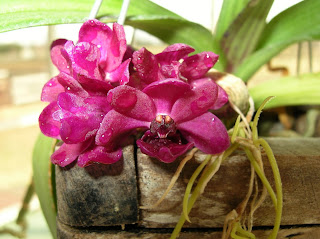 This is a first bloom seedling of a 'red' (actually more like magenta) form of Rhynchostylis gigantea. The species comes in a few other color forms, the most common probably being white with pink markings. Flowers are lightly, but sweetly scented, and borne in high numbers on a mature plant. Also, the leaves have interesting longitudinal stripes for added interest. It is not a very big plant though, despite the name.
This is a first bloom seedling of a 'red' (actually more like magenta) form of Rhynchostylis gigantea. The species comes in a few other color forms, the most common probably being white with pink markings. Flowers are lightly, but sweetly scented, and borne in high numbers on a mature plant. Also, the leaves have interesting longitudinal stripes for added interest. It is not a very big plant though, despite the name.
Mine lives in an East-facing window in a 4-inch basket with diatomite, and gets watered ever day or every other day. Some sources say it requires higher, cattleya type light but since this one bloomed in lower light that may not always be the case.
 At the right is Bulbophyllum grandiflorum 'Yellowstone River' AM/AOS. I bought this as a few growth division from Woodstream a few years back. The flowers are large at something like 4 inches long and develop quickly from a just started inflorescence to open flower like other bulbophyllums. I have not noticed any fragrance but I haven't gone looking either since some bulbos are very offensive. This plant is creeping around in a 10-inch pot, also in an east facing window.
At the right is Bulbophyllum grandiflorum 'Yellowstone River' AM/AOS. I bought this as a few growth division from Woodstream a few years back. The flowers are large at something like 4 inches long and develop quickly from a just started inflorescence to open flower like other bulbophyllums. I have not noticed any fragrance but I haven't gone looking either since some bulbos are very offensive. This plant is creeping around in a 10-inch pot, also in an east facing window.
Here are a few snapshots I took at the 2008 Paph Forum, for those of you who were not able to make it to this event.
 First up we have Phrag. Fritz Schomburg 'Katherine', exhibited by H.P. Norton. The flower had large size, full shape, and pleasing art-shade color. Parentage is (kovachii x besseae), registered by Piping Rock Orchids, but I believe the Norton's bred this one themselves. HP spoke on kovachii's special needs at the forum, explaining to us all that this species requires significant amounts of lime in the media. He says if you meet this need the plants are speedy growers, reaching flowering size in his greenhouse from seed in about 2 years. Additionally, HP has bloomed several assorted kovachii hybrids and he says that none have bloomed out that wonderful dark purple that the species is noted for.
First up we have Phrag. Fritz Schomburg 'Katherine', exhibited by H.P. Norton. The flower had large size, full shape, and pleasing art-shade color. Parentage is (kovachii x besseae), registered by Piping Rock Orchids, but I believe the Norton's bred this one themselves. HP spoke on kovachii's special needs at the forum, explaining to us all that this species requires significant amounts of lime in the media. He says if you meet this need the plants are speedy growers, reaching flowering size in his greenhouse from seed in about 2 years. Additionally, HP has bloomed several assorted kovachii hybrids and he says that none have bloomed out that wonderful dark purple that the species is noted for.
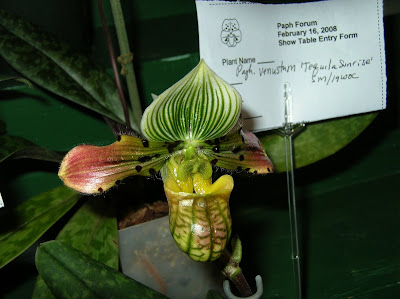 This is Paph. venustum 'Tequila Sunrise'. This nicely colored flower was awarded a Silver Medal at the 19th World Orchid Congress, but the judges at the Paph Forum decided the flower was not at its best anymore and decided not to add an AOS award at that time. Perhaps it will get one on the next blooming. The flower had good size for venustum, and very appealing color on the petals.
This is Paph. venustum 'Tequila Sunrise'. This nicely colored flower was awarded a Silver Medal at the 19th World Orchid Congress, but the judges at the Paph Forum decided the flower was not at its best anymore and decided not to add an AOS award at that time. Perhaps it will get one on the next blooming. The flower had good size for venustum, and very appealing color on the petals.
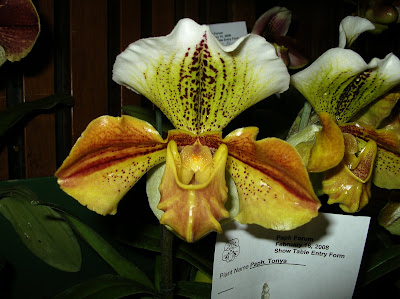 This rather odd looking thing is Paph. Tonya. It was given a first place ribbon in its class and the judges commented that the extra tissue ridges on the pouch. The judges commented that many of us have seen that occur on the odd complex paph flower, but that of course this is rarely either consistent or symmetrical. This plant however had three flowers and all had symmetrical ridges as you see on this flower.
This rather odd looking thing is Paph. Tonya. It was given a first place ribbon in its class and the judges commented that the extra tissue ridges on the pouch. The judges commented that many of us have seen that occur on the odd complex paph flower, but that of course this is rarely either consistent or symmetrical. This plant however had three flowers and all had symmetrical ridges as you see on this flower.
 This specimen of Paph. Snowbird 'Opalescence' AM/AOS, CCM/AOS (82pts) was exhibited by Woodstream Orchids. My photo does not do the plant justice. It is a very well grown plant with around 8 flowers and 5 buds. The CCM was awarded at the paph forum and the plant got a blue ribbon in its class.
This specimen of Paph. Snowbird 'Opalescence' AM/AOS, CCM/AOS (82pts) was exhibited by Woodstream Orchids. My photo does not do the plant justice. It is a very well grown plant with around 8 flowers and 5 buds. The CCM was awarded at the paph forum and the plant got a blue ribbon in its class.
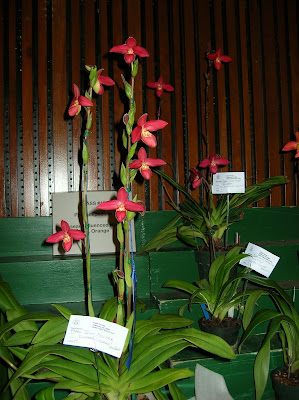 Similarly, this plant of Phrag. Jason Fischer 'Linwood Coleman' HCC/AOS is a very nicely grown plant. The judges commented that they had not seen another Jason Fischer with quite so many flowers and buds at one time. Indeed it was a striking specimen and a cinch for the blue ribbon in the "red and orange besseae-influenced hybrids" class, as well as a few other rosettes.
Similarly, this plant of Phrag. Jason Fischer 'Linwood Coleman' HCC/AOS is a very nicely grown plant. The judges commented that they had not seen another Jason Fischer with quite so many flowers and buds at one time. Indeed it was a striking specimen and a cinch for the blue ribbon in the "red and orange besseae-influenced hybrids" class, as well as a few other rosettes.
 Paph. Magic Dust 'Pixie'- a lovely shape and clean color on this plant. We were reminded at the forum of Merit Huntington's habit of looking at the backside of a complex paph to see if it was "round, firm, and fully packed." This young plant did quite nicely on the test.
Paph. Magic Dust 'Pixie'- a lovely shape and clean color on this plant. We were reminded at the forum of Merit Huntington's habit of looking at the backside of a complex paph to see if it was "round, firm, and fully packed." This young plant did quite nicely on the test.
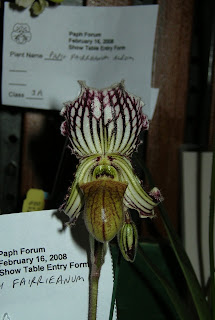
 I'll end with two species photos, Paph. farrieanum on the right, displayed by Woodstream Orchids, and Paph. appletonianum 'Valley Fields hainanense' on the bottom. This appletonianum has particularly dark color for the species and was quite appealing. Dr. Leonid Averyanov of the Russian Academy of Science spoke to us on the "Natural Variation of Paphiopedilum Species in Vietnam". P. appletonianum was one of the species he mentioned. Once a common species, now difficult to find, it grows in primary forests at high elevation in silicate areas. Habitat contains heavily mossed trees with open leaf litter between them. It seems there are many species of Vietnam that are threatened in their natural habitats due to land development.
I'll end with two species photos, Paph. farrieanum on the right, displayed by Woodstream Orchids, and Paph. appletonianum 'Valley Fields hainanense' on the bottom. This appletonianum has particularly dark color for the species and was quite appealing. Dr. Leonid Averyanov of the Russian Academy of Science spoke to us on the "Natural Variation of Paphiopedilum Species in Vietnam". P. appletonianum was one of the species he mentioned. Once a common species, now difficult to find, it grows in primary forests at high elevation in silicate areas. Habitat contains heavily mossed trees with open leaf litter between them. It seems there are many species of Vietnam that are threatened in their natural habitats due to land development.
